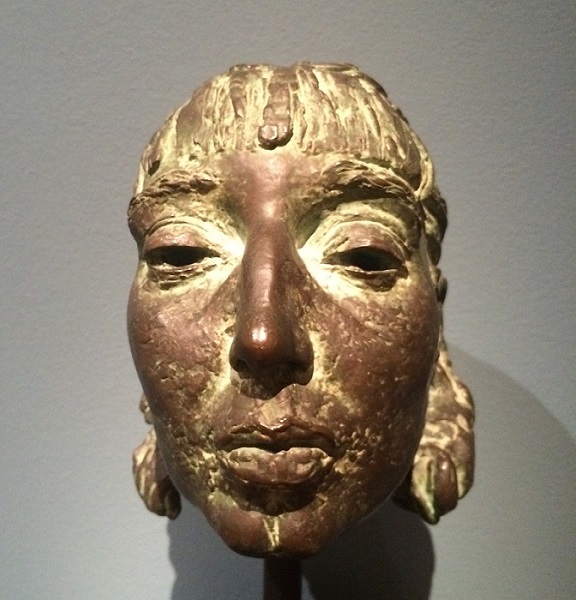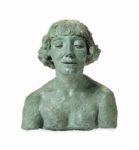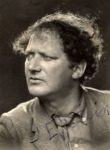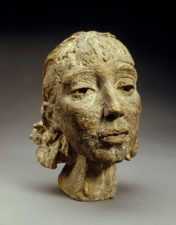


Sir Jacob Epstein
British, 1880-1959
Fourth Portrait of Dolores (Head), 1923 ca.
bronze
10 x 9 in.
SBMA, Bequest of Wright S. Ludington
1941.2.11

Epstein photo by George Charles Beresford, 1921
"The artist who imagines that he puts his best into a portrait in order to produce something good, which will be a pleasure to the sitter and to himself, will have some bitter experiences." - Sir Jacob Epstein
RESEARCH PAPER
Portrait of Dolores was the fourth and last of the heads that Epstein cast of the model of the same name, a professional model of great beauty. Her endless amours were a boon to Fleet Street journalists, but in this case Epstein has chosen to represent this colorful character in the mood and form of a mask. Dolores was an expressive model, was devoted and serious about her profession, and never allowed anything to interfere with posing. Epstein regarded this last head of her as his best portrait of her.
Sir Jacob Epstein is known as an English artist; however he was born and brought up on the lower east side of New York. He was a student at the Art Student League and, to improve his drawing, he entered a sculpture class and discovered his real talent. With only one sculpture studio in New York, he turned toward Europe. With money earned from illustrating a book, he left for Paris and was accepted at Beaux Artes Academy. After six months he shifted to the Julian Academy. A sojourn in England helped him to decide to take a studio in London and study on his own. He spent much time in the British Museum studying sculpture from Egypt, Africa, and Polynesia. In 1907 he received his first commission, to decorate the British Medical Association Building. It consisted of eighteen figures showing man from birth to death. In 1911 he returned to Paris to complete a figure for the tomb of Oscar Wilde. At this time he became friends with Picasso, Brancusi, and Modigliani.
His sculpture work spanned a range of styles, from the romantic impressionism of Rodin to the abstract expressionism of Brancusi. He was a great portrait sculptor and his portraits included Joseph Conrad, Paul Robeson, John Dewey, George Bernard Shaw, Albert Einstein, T.E. Hulme, and Augustus John. However he stated that “my best work has been with professional models and family”.
Prepared for the Santa Barbara Museum of Art Docent Council by Katherine Griffin, October 1982
Reference: Black, Robert, “Art of Jacob Epstein”, World Publishing Co., New York.

This is the initial casting plaster for the 1923 head of Dolores, Epstein’s fourth and final portrait of her.
COMMENTS
Description / Expertise
Dolores, a cabaret singer who was also known as The Queen of the London Studios, was one of Jacob Epstein’s favourite models. This is the initial casting plaster for the 1923 head of Dolores, Epstein’s fourth and final portrait of her.
The final plaster, from which Epstein cast a small edition of bronzes, has a different shape to the base of the neck and a less textured surface (see illustrations in Rutherstone, plates 27 & 28).
My first work from Dolores I abandoned and thought a failure, and yet years afterwards, when I came across the plaster again, I realised that it was a very vivid and spontaneous sketch of her, and I cast it in bronze. It became instantly popular.
The second study was again a failure, I thought, but this I followed up with a bust which was tragic and magnificent; Dolores was a model who was extremely suggestionable, and after I made this bust, she always strutted about, keeping her arms folded in the pose of the bust, and with the same tragic and aloof expression fixed upon her face, and she took great care that she never relaxed into those careless smiles of the first head. In the studio she was the devoted model, never allowing anything to interfere with posing, taking it seriously; a religious rite. She became the High Priestess of Beauty, and this role she carried to ridiculous lengths. She even gave as an excuse to a magistrate, before whom she appeared for some indiscreet conduct in Piccadilly, that my being in America had disorientated her, and this was taken as sufficient excuse, together with a small fine, by a magistrate indulgent to a Phryne of modern times.
In 1923, I made one more head of her, which I think is the best work I did from the beautiful and fantastic Dolores. Later I can remember how, passing through Piccadilly, a strange vehicle of period 1840 or so met my gaze; complete with high stepping horses, coachman with whip, and footman. Dolores was mounted on a high seat with folded arms and the air of a Queen as she passed majestically to advertise some perfume or cosmetic. Her sang-froid carried her into some strange adventures, but the use she made of my name was sometimes embarrassing, as when she married a coloured gentleman and sent out the invitations to the reception in my own name. Her endless amours were a boom to Fleet Street journalists, and when she died of cancer, suddenly, they must have regretted the passing of a character so colourful and so accessible.
In Dolores’ biography The Fatal Woman of the London Studios- The most famous artists’ model of Modern Times, for whom three men have killed themselves (a 'Vampire who destroyed a soul' she has been called)’, reveals the secrets of her own extraordinary career she recounts:
...I still enjoyed my Vie de Boheme, because I found there an all-embracing understanding and more real morality than a cathedral city. The lurid stories of Chelsea don’t touch art as it ought to be spelled. Certain smart people, however, use art and studio as a cover for their own immorality but your true artist, never rubs shoulders with them. And when it’s a case of choosing artists or actors as friends, give me artists. They are much more generous, and much less prone to bragging.
Jacob Epstein’s own response was:
Her memoirs published by the Hearst Press in America were packed full of inventions conceived by the not very scrupulous brains of the scribblers who seized on her notoriety and exploited it.
http://www.leicestergalleries.com/19th-20th-century-paintings/d/modern-british/jacob-epstein/11651
SBMA CURATORIAL LABELS
Epstein was born in New York the son of Polish immigrants. After training at the Art Students’ League he moved to Paris in 1902, to continue his studies before settling in London where, in 1907, he received his first major commission, the carving of eighteen over life- size naked figures for the facade of the British Medical Association building in the Strand. Their unveiling provoked the first of the many scandals with which his name was to be associated. His work in bronze, particularly his portraiture, was always more traditional and his sitters included Winston Churchill and Albert Einstein as well as many exotic female models.
- British Modernism from Whistler to WWII, 2016
